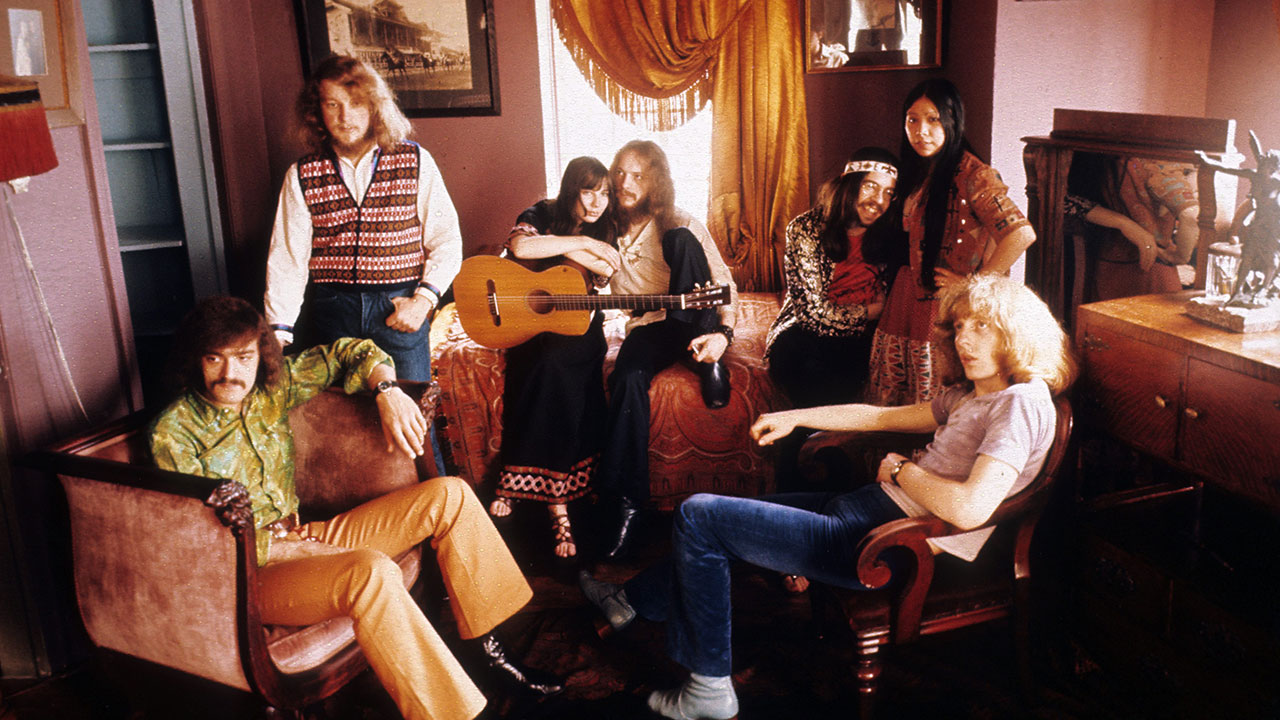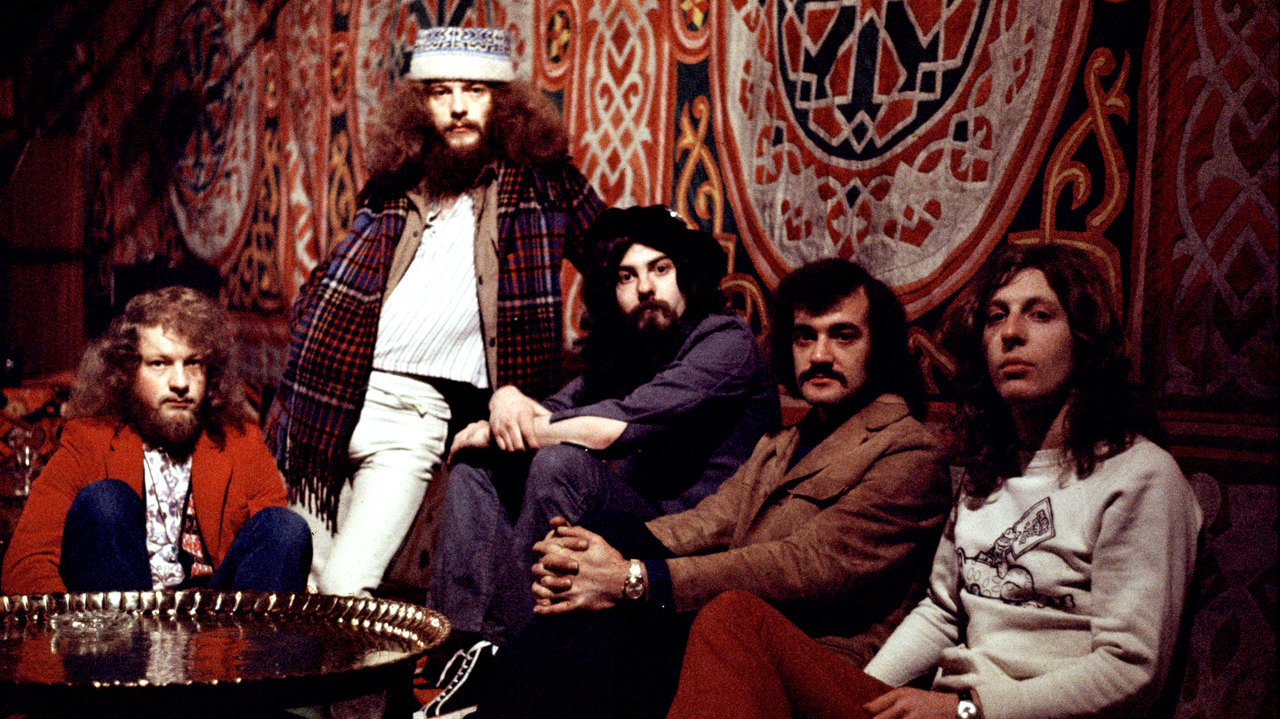No-one sounds like Jethro Tull. For a band that have prospered for almost as long as some of the genres they occupy have existed, they are without imitators. Their twenty-one studio records have taken in English folk and baroque instrumentation, plus the thunderous and unforgettable riffs of Martin Barre that saw them edge Metallica and AC/DC out of a Grammy for best Hard Rock band. So it’s a daunting yet thoroughly pleasurable task, to rank a body of work like no other…
21) The Jethro Tull Christmas Album (2003)
It’s not that it’s bad, more that Christmas music has its two-week window before it’s blasted into oblivion for another twelve months by the Boxing Day sales. Ian Anderson is uniquely placed among rock musicians to do this well – he has the lightness of touch and a feel for the right mix of sincerity and humour – and his original songs are lovely. Every minute listening to it is at least 60 seconds spared from ‘Merry Xmas Everybody’.
20) Under Wraps (1984)
Anderson is too skilled an artist to produce music devoid of merit, but Under Wraps with its remote electronica and themes of paranoia in the Cold War, would perhaps have worked better as a follow-up to his solo record, Walk Into Light.
19) J-Tull Dot Com (1999)
Nothing dates a record like a title that alludes to the internet’s then-newness. How the novelty has worn off. Tull returned to straight-ahead adult-oriented rock after the World music whispers of Roots To Branches, and while it’s competently, lovingly done, it’s hard to shake the feeling that they have done it better before.
18) This Was (1968)
Controversial, maybe, to place the band’s first record so low on a list like this, but This Was merely hints at the band Tull would become. It’s a record bossed by the guitarist Mick Abrahams, a revered R&B and hard blues player who would go on to form Blodwyn Pig, and as such offers a view of the road not taken. A three-week dalliance with Tony Iommi followed, before the comforting arrival of the future and Martin Barre.
17) Rock Island (1989)
As ever with Anderson there are some lovely songs on a record he wrote in part of the Isle of Skye. The title track is a study of isolation, Strange Avenues, according to Anderson’s liner notes, a sequel to “the Aqualung setting”. Kissing Willie was less subtle though, and came with a Storm Thorgerson video based on Benny Hill that Anderson went along with “regretfully”.
16) A (1980)
A kind of chaos, and some heartbreak, surrounded A, an album originally planned as an Anderson solo release. The death of bassist John Glascock and the subsequent depression and departure of Barriemore Barlow changed Tull radically. On the cover of A, they are clad in white jumpsuits, free of their past, and the music is similarly stripped back, Eddie Jobson’s violins and synths bringing the art rock feel of his previous bands Roxy Music and King Crimson.
15) Catfish Rising (1991)
Split between some contemporary bluesy rockers (Sleeping With The Dog) and the sharp modern AOR stylings they’d begun on Crest Of A Knave (Sparrow On the Schoolyard Wall), Catfish Rising continued the late-era Tull trend for smooth and mature rock music, as comfy as an old jacket.
14) Stormwatch (1979)
The third record in a loose trilogy begun by Songs From The Wood and Heavy Horses, Anderson turned his attention from the distant past (Songs…) and the rapidly receding one (Heavy Horses) to a threatening near-future: North Sea Oil and Dark Ages took on the environmental and economic consequences of the modern age. Sometimes bleak, Stormwatch lacks the flat-out classic tunes of its companions.
13) Roots To Branches (1995)
Roots To Branches is to a degree anomalous, mixing standard motifs of Barre’s fluent, head-tossing riffs and Anderson’s percussive flute-playing with some Eastern influences drawn from a trip the singer made to India. He felt that the songs echoed some of Tull’s earliest work on Stand Up… Maybe so, but it was unprecedented in the band’s late era, and made Roots to Branches – after Crest Of A Knave – the most restless and inventive record of their final years.

12) A Passion Play (1973)
Pilloried on its release, A Passion Play has gained a more sympathetic audience as years have passed, and deservedly so. It was perhaps a victim of its time – another apparently impenetrable concept record in an era stuffed full of them - and it also came a year after Thick As A Brick, a record that had sent up the entire notion of concept albums in dazzling style. An inversion of the Passion Plays, it follows Ronnie Pilgrim (maybe a nod too to Vonnegut’s Billy Pilgrim) on his purgatorial journey in quaint but convoluted style.
11) Minstrel In The Gallery (1975)
There are parts of Minstrel…, especially in the near 20-minute Baker Street Muse and Cold Wind In Valhalla, that are the equal of the songs on Aqualung or Thick As A Brick, Anderson’s beautiful acoustic playing (especially on Requiem) a perfect match for Barre’s ferocious electric, but there is some wibble too, the band in the grip of a release schedule that saw them issue an album a year – astonishingly – from 1968 until 1980.
10) Stand Up (1969)
Anderson’s emergent song writing was delving into his upbringing (Back To The Family) and making use of his sharp eye for the absurdities of everyday life (Fat Man, Jeffrey Goes To Leicester Square) on Stand Up, a record that also had his lovely reworking of Bach’s Bouree. The pop-up cover showed his desire to push the form in every way he could.
9) Crest Of A Knave (1987)
The electro era that had taken in Under Wraps was over, and in its place came Crest’s commercial rock groove. Throat trouble seemed to limit Anderson’s range, but his best vocals are all about character and he was back on fertile ground here, eyeing up a girl ‘with legs that went on forever’ in the outstanding Budapest and drinking in a bar with another in She Said She Was A Dancer. Crest… was the record that beat Metallica to a Grammy. So is it better than And Justice For All? Of course it is.
8) War Child (1974)
War Child started out as another grand notion – this time a film project starring Leonard Rossiter – and when that fell apart, Tull pared the planned double album back to a far tighter, harder single record distinguished by Bungle In The Jungle and perhaps Anderson’s greatest stand-alone acoustic song, the gorgeous Skating Away On The Thin Ice Of The New Day.
7) Benefit (1970)
Benefit was the sound of a band finding its future. Anderson and Barre nailed their electric-acoustic interplay on songs like Son, and Anderson was quickly emerging as a composer of some originality. The great trick was incorporating Barre’s gift for memorable riffs and hooks into his delicate melodies - once they’d done so the Tull sound was established.
6) Too Old To Rock N Roll… Too Young To Die (1976)
Typically offbeat and funny, Too Old To Rock n Roll describes the life of Anderson’s alter ego, Ray Lomas, a washed-up former rock star. Lomas wins some money on a quiz show but finds life has changed so much he can’t enjoy it. Resolving to kill himself on his motorbike, he instead ends up in a coma and when he re-emerges finds that he and everything he likes is back in fashion again. Anderson’s point is the pointlessness of chasing trends.
5) Heavy Horses (1978)
Perhaps Tull’s most gentle and reflective album, Anderson was looking back at an England in which long-held traditions of the countryside were being paved over. The title track is one of his most earnest, but bursts into life with a stirring electric fiddle riff, while Acres Wild, One Brown Mouse and Moths are filled with wistful melody.
- Ian Anderson – the 10 Records That Changed My Life
- The Top 10 Best Rush Songs Of The 80s
- The Top 10 Greatest Prog Album Covers Ever
- Jethro Tull: the story behind Thick As A Brick
4) The Broadsword And The Beast (1982)
An atmospheric, witty, occasionally lusty record with a powerful sense of mood to drive it along, Broadsword divided fans with its synthesisers, but stands as one their finest and most cohesive works. There were effectively two title tracks: the filmic, stately Broadsword, and Beastie, a fizzing evocation of childhood fears. Broadsword is the kind of record that requires submission to its whimsy, but it’s a whole heap of fun.
3) Songs From The Wood (1977)
Bucolic and beautiful, Songs From The Wood is a folk album made by a rock band. The subject matter bestows an almost otherworldly quality: Jack In The Green evokes the Green Man of English myth. Anderson proves a convincing guide along these leafy trails, but it wouldn’t work without the tunes, and there are some sublime acoustic melodies. Enjoy too the rollicking Hunting Girl, in which Anderson, back in dirty old squire mode, encounters a lusty lass of the fields.
2) Thick As A Brick (1972)
Anderson’s waspish wit was at work throughout Thick As A Brick a satire of concept albums presented as – what else – a concept album of ludicrous convolution. The story concerns the titular fictional poem, ‘written’ by schoolboy, Gerald ‘Little Milton’ Bostock, who wins a competition with his verse and then has the prize revoked after using a ‘fruity’ word on TV. Really, it was a sideways look at an English childhood. Movingly, and rather brilliantly, Anderson returned to Gerald’s story in his 2012 solo record Thick As A Brick 2, offering five alternative futures for a boy wonder broken by life.
1) Aqualung (1971)
It begins with a tramp sitting on a park bench ‘watching as the frilly panties run’ and ends with a meditation on the nature of God – Tull in a nutshell, really. Aqualung is high on ambition and sardonic rage. The first half introduces Aqualung the tramp, ‘eying little girls with bad intent’ and Cross-Eyed Mary, the good-time girl who ‘will do it for a song’. Both are archetypes that Anderson would return to again and again.
The second half deals directly with Anderson’s perceived disconnection between God and the church, an unlikely subject that he handles with his usual deft intelligence. A high water mark in a classic era for great rock records.

